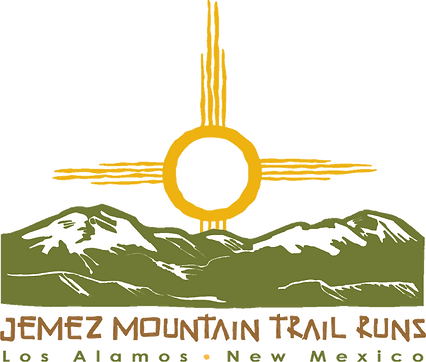
You Run Hard, You Get Stuff
Handmade Jemez Pueblo pottery awards will be given to all finishers in the 50k and 50 mile events. All finishers of the 15 mile race will receive a handmade Jemez Pueblo medallion. The top 3 overall male and female finishers in all three races will receive larger pottery bowl awards. The award will be original, handmade pottery by the Toya family of the Jemez Pueblo.

Multi-year finishers who surpass 50,000 feet cumulative climbing with a successful finish will receive a special commemorative pint glass to recognize their accomplishments and loyalty to the Jemez Mountain Trail Runs.
All runners are invited to a post-race party at the start/finish area lasting until everyone finishes the race.
About the pottery makers, Benjamin and Geraldine Toya:
Benjamin and Geraldine Toya have been creating beautiful, fine line, eye dazzling pottery for 27 years. Benjamin is of the Acorn Clan, Gearaldine of the Coyote Clan. Family Traditions carries on what they have learned from their families passed down through many generations. The Toyas have been awarded Best of Show in pottery at the New Mexico State Fair for eight consecutive years, 1998-2005. They have also been awarded 1st place in 2004 and 2005 at the Jemez Red Rocks Memorial Art Show. Their work is a part of the permanent collection at the Albuquerque Sunport airport and the City of Albuquerque Art program. They've been demonstrating at the Santa Fe Indian Market for 6 years and at the New Mexico State Fair for 8 years.
Each pot is handcrafted by the Toya family of the Jemez Pueblo in Northern New Mexico and therefore no two are exactly the same. The process in crafting the pottery is extensive and described below.
First the clay is dug by hand, 5 gallons at a time. All sticks, rocks and impurities are removed via sifting through a large wire mesh then through smaller wire mesh until it is pure.Volcanic ash is dug by hand, and mixed 1 gallon to the 5 gallons of clay. The ash must also be cleaned of sticks, rocks and impurities. The ash is worked through a very fine silk cloth until it resembles talcum powder. The clay and ash are mixed together with water to form a workable material. The clay is rolled by hand into long strands. The strands are coiled to form the pot, then the coil pot is smoothed by hand.
The red and white paint on the pot is made from boiling rocks the Toyas have gathered. The black paint is made from boiling wild spinach they have harvested. After the spinach has been boiled it is then buried along with native prayer. The turquoise paint is made from dried, ground up mulberries.
Per tradition, the rocks, spinach and mulberries are boiled only in rain water that is collected and stored in jars until it is used for the boiling.
